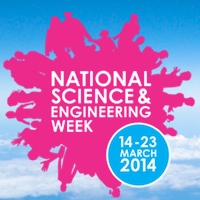Tweeting for Science - Citizen Science meets Social Media
Event Info
Description
Join us for an evening of discussion about how Citizen Science projects are using Social Media to involve individuals in real science.
- Hear from the scientists and researchers behind inspiring citizen science projects
- Chat with creative minds from the world of digital & social media
- Discuss 'How else can Citizen Science use Social Media?' - our challenge to you, the audience
SCHEDULE
6:00 - Doors Open
6:30 - Introduction to Citizen Science (Margaret Gold)
6:35 - Speakers share examples of Social Media in Citizen Science
7:40 - Q & A with the Speakers (Monica Lobo & Toby Shannon)
8:00 - Introduction to the Challenge (Brian Fuchs)
8:10 - Group Discussions at the Tables over drinks
8:50 - Brief ‘Show & Tell’ of the discussion outcomes.
MODERATORS
- Toby Shannon & Monica Lobo - British Science Association
SPEAKERS
- Margaret Gold - Citizen Cyberlab
- Grant Miller - Zooniverse (Galaxy Zoo, Old Weather)
- Erinma Ochu - Hooked, Everyday Growing Cultures and Turing's Sunflowers
- Dominic Furniss - Error Diary
- Dan Maclean - Fraxinus
- Brian Fuchs - Citizens of Science
What is Citizen Science?
Citizen Science is real science done collaboratively by amateurs, volunteers, and enthusiasts around the globe. People are classifying galaxies from their computers, monitoring the health of trees in their community, transcribing weather reports from old naval logs, and gathering data on their mobiles to make a real contribution to scientific research.
One emerging branch dubbed “Extreme Citizen Science” provides tools that can be used by any individual, regardless of their level of literacy, to collect, analyse and act on information by using established scientific methods. This allows any community to start a Citizen Science project to deal with the issues that concern them - from biodiversity to food production, involving communities from housing estates in London to hunter-gatherers and forest villagers in the Congo Basin.
What is the role of Social Media?
Social Media include discussion forums, blogs, wikis, tweets, voting, picture sharing and rating sites as well as social bookmarking. When mobile devices are added to the mix, Social Media often involve sharing real-time mobile information such as location (e.g. Foursquare) media use as well as user-generated content, such as photos.
Many Citizen Science projects are now taking advantage of mobile phones and tablets for easy data collection, such as iPhone apps for monitoring birds and marine wildlife or the NASA Meteor Counter app. Discussion forums have always played a major role in Citizen Science, but the full potential of Social Media for Citizen Science has only just begun to be tapped.
Some examples of Social Media in Citizen Science projects include GeoTag Libya - which used metadata from photo-sharing sites like flickr and twitter to geo-locate thousands of photos of areas affected by military operations to help UNOSAT experts assess damage to civilian infrastructure; and Aurorasaurus - which uses twitter to aggregate and share real-time data about aurora borealis sightings around the world.


